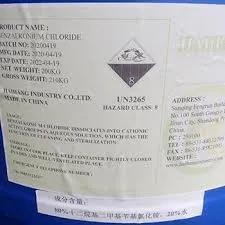industrial flocculant
Understanding Industrial Flocculants Their Role and Applications
In the industrial sector, the efficient management of water and wastewater has become increasingly critical due to regulatory pressures and the need for sustainable practices. One essential component in this process is the use of flocculants. These chemical substances facilitate the aggregation of fine particles in liquids, making them easier to separate and remove. This article explores the role of industrial flocculants, their various applications, and the benefits they offer across multiple industries.
What Are Flocculants?
Flocculants are chemical agents that promote the clumping or agglomeration of suspended particles in a liquid. When added to a slurry or suspension, flocculants help settle solids through a process called flocculation. This process is essential in various industries, including wastewater treatment, mining, and paper manufacturing, among others.
Flocculants can be categorized into two main types anionic and cationic. Anionic flocculants carry a negative charge, while cationic flocculants carry a positive charge. The choice of flocculant largely depends on the specific application and the characteristics of the materials being processed.
Applications of Industrial Flocculants
1. Wastewater Treatment One of the most significant applications of flocculants is in wastewater treatment plants. They are used to enhance the sedimentation process of suspended solids, thereby reducing the effluent turbidity and meeting stringent environmental regulations. Flocculants facilitate the separation of solids from liquids in both municipal and industrial wastewater systems.
2. Mining Industry In mining operations, flocculants are employed to enhance the recovery rate of valuable minerals during ore processing. They help in separating the fine particles of minerals from the water, allowing for better concentration and purification of extracted materials.
3. Paper Production The paper industry relies heavily on flocculants for the efficient production of pulp. By aggregating fibers and fillers, flocculants improve the drainage rates in the paper-making process, leading to better quality paper and reduced energy consumption.
industrial flocculant

4. Food and Beverage Sector In the food and beverage industry, flocculants are used to clarify liquids such as fruit juices and wines. They help remove unwanted particles and improve the overall quality of the finished products.
5. Oil and Gas In the oil and gas sector, flocculants play a crucial role in separating water from crude oil during the extraction and refining processes. This separation is vital for ensuring the quality of the final product and minimizing environmental impacts.
Benefits of Using Flocculants
The use of industrial flocculants offers several benefits for businesses. Firstly, they significantly enhance the efficiency of separation processes, which can lead to substantial cost savings. Reducing the volume of sludge produced during treatment processes can also lower disposal costs and environmental impact.
Additionally, flocculants contribute to improved water quality. By effectively removing suspended solids, they help meet discharge regulations and contribute to cleaner water bodies, promoting sustainability.
Moreover, the versatility of flocculants allows them to be tailored for specific applications. This customization ensures that industries can choose the most effective flocculants, maximizing their operational efficiency and product quality.
Conclusion
As industries face increasing challenges related to water management and environmental regulations, the role of industrial flocculants cannot be understated. Their ability to enhance the separation of solids from liquids makes them indispensable in various sectors, from wastewater treatment to mining and food production. By investing in efficient flocculant solutions, companies can not only reduce operational costs but also contribute to a more sustainable future. As technology advances and new formulations emerge, flocculants will continue to evolve, further enhancing their effectiveness and broadening their applications in industrial processes.
-
Pbtc Scale InhibitorPBTC: A Scale Protector for Industrial Water TreatmentNewsAug.05,2025
-
Organic Phosphonate: An Efficient Defender in the Field of Scale InhibitionNewsAug.05,2025
-
Hydrolyzed Polymaleic Anhydride: Green Pioneer in Scale Inhibition FieldNewsAug.05,2025
-
PAPEMP Polyamino Polyether Methylene Phosphonic Acid For SaleNewsAug.05,2025
-
Flocculant Water Treatment: A Pioneer in Purification in the Field of Water TreatmentNewsAug.05,2025
-
Benzyl Isothiazolinone: An Efficient and Broad-Spectrum Antibacterial Protective GuardNewsAug.05,2025





